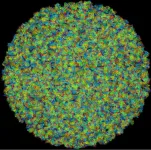(Press-News.org) LAWRENCE — A partnership between scientists at the University of Kansas and collaborators in Europe, including war-torn Ukraine, will result in computer models of biological cells likely to hasten health breakthroughs by simulating molecular interactions inside cells with near experimental accuracy at vastly longer timescales than similar efforts.
The research is supported by the National Science Foundation’s IMPRESS-U (International Multilateral Partnerships for Resilient Education and Science System in Ukraine) program that aims to “support excellence in science and engineering research, education, and innovation through international collaboration and promote and catalyze integration of Ukrainian researchers in the global research community.”
The cell-modeling approach underpinning the research was pioneered in the lab of Ilya Vakser, professor of computational biology and molecular biosciences and director of the Center for Computational Biology at KU. Vakser’s group is one of the foremost in the world in modeling macromolecular interactions.
“Our extra-long simulation time scales will allow us to investigate macromolecular interactions in the environment that approximates the actual content of a cell,” said Vakser, the principal investigator. “The approach we put forward is about a million — and I mean a million — times faster than alternative approaches developed elsewhere.”
The method allows Vakser’s team to re-create physiological phenomena in cells that are much longer and more relevant to biology and medicine, with a wide range of applications to fundamental science and medicine.
"What we're doing is a virtual cell,” Vakser said. “It's a biological cell that exists in the computer. And it allows us to investigate all kinds of biological phenomena at atomic resolution, such as the effects of genetic mutations. For example, what changes if this part of the protein mutates? We can see potentially the consequence of that. Also, we will be able to drop a virtual drug into this model and see again how the cell reacts — what changes? So that's a totally new opportunity for computer-aided drug design."
The KU researcher’s key investigative collaborators are Ceslovas Venclovas of Vilnius University in Lithuania and Pavlo Kasyanov of the National Technical University of Ukraine Igor Sikorsky Kyiv Polytechnic Institute in Kyiv.
Vakser said Kasyanov’s team in Ukraine are leaders in massive parallel computing and artificial intelligence, boosting the computing power available to the cell-modeling technique honed at KU.
“We met with our colleagues in Ukraine through a common colleague, and they’re one of the leading groups in massive parallel computing and artificial intelligence,” Vakser said. “We started collaborating, and what they're doing is adapting our approach for massive parallel computing and artificial intelligence, which would speed it up further by orders of magnitude, with implications that are hard to imagine now. It's a breathtaking development, which we're super excited about. It could be a huge thing for science and medicine in the relatively short term.”
Vakser said his Ukrainian collaborators highlighted the resilience of scientific pursuit.
“It’s remarkable how our colleagues, even in a war environment where bombs are falling, are able to do first-grade science, which is amazing for all of us,” he said.
In addition to providing educational training to KU students, the resulting computer simulation technology will be provided to the wider research community via an open-access web platform.
“We’re developing a public resource that will provide the opportunity for anybody in the world with a research interest in this to try this model and see how it works,” Vakser said. “It's an entry point for them to do the modeling themselves.”
The grant and partnership underscore KU’s status as a leader in computer simulations of biological processes, according to Vakser.
“We are pioneering this research, and it's on the radar around the world among the key figures in computational biology field,” he said.
END
Researchers in US, Ukraine simulate cell activity at ‘breathtaking’ timescales
2024-06-12
ELSE PRESS RELEASES FROM THIS DATE:
NSF CAREER grant to investigate design of fluorescent protein sensors with computer simulations that may aid human health and disease
2024-06-12
DETROIT — Alice Walker, Ph.D., assistant professor of chemistry in the College of Liberal Arts and Sciences at Wayne State University, received a Faculty Early Career Development (CAREER) award from the National Science Foundation to fund her research on applying computational chemistry to the understanding and rational design of new fluorescent protein (FP) sensors.
“A sensor, chemically speaking, is a molecule that turns on or off in response to certain stimuli,” said Walker. “Proteins are good sensors because they have a florescent element; they essentially glow in the dark in response to when it touches something. ...
Study shows politicians deny misdeeds because we want to believe them
2024-06-12
Why do politicians lie and deny when they are caught up in political scandal?
According to a newly published study led by a University of Nebraska–Lincoln political scientist, the answer may be that their supporters prefer a less-than-credible denial to losing political power and in-group status because of a discredited standard-bearer.
“The driving question of our research is whether people are actually incentivizing politicians to deny wrongdoing and escape accountability,” said Pierce Ekstrom, assistant professor of political science at Nebraska.
“Certainly, there’s a very strong norm ...
Case study reveals important new details about rare second cancers related to CAR-T therapy
2024-06-12
WASHINGTON – A new detailed analysis of a patient’s second cancer after receiving CAR-T therapy for the initial cancer provides rare but important insights intended to offer helpful guidance for oncologists and pathologists about the clinical presentation and pathologic features involved in a CAR-T related second cancer.
The finding is reported June 13, 2024, in the New England Journal of Medicine.
CAR-T therapy is described by many as a new and promising treatment for blood cancers. CAR-T therapy is made from a patient’s ...
Risk of secondary cancers after CAR-T cell therapy low, according to large Stanford Medicine study
2024-06-12
A large study by researchers at Stanford Medicine has found that the risk of secondary blood cancers after CAR-T cell therapy — a cell-based cancer treatment that exploded on the scene in 2017 as a treatment for intractable blood cancers — is low, despite a Food and Drug Administration warning.
In November 2023, the FDA issued a warning about a risk of secondary cancers — particularly blood cancers — that may be associated with CAR-T cell therapy. The warning was preceded by a rising tide of ...
Mouse study identifies unique approach for preventing life-threatening complications after spinal cord injury
2024-06-12
COLUMBUS, Ohio – In response to stressful or dangerous stimuli, nerve cells in the spinal cord activate involuntary, autonomic reflexes often referred to as “fight or flight” responses.
These protective responses cause changes in blood pressure and the release of stress hormones into the blood stream. Normally, these responses are short-lived and well-controlled, but this changes after a traumatic spinal cord injury.
A first-ever study published in the journal Science Translational Research identifies a ...
Western agricultural communities need water conservation strategies to adapt to future shortages
2024-06-12
Reno, Nev. (June 12, 2024) – The Western U.S. is heavily reliant on mountain snowpacks and their gradual melt for water storage and supply, and climate change is expected to upend the reliability of this natural process. Many agricultural communities in this part of the country are examining ways to adapt to a future with less water, and new research shows that a focus on supplementing water supply by expanding reservoir capacity won’t be enough to avert future water crises.
Led by scientists at the Desert Research Institute ...
Does having a child with low birth weight increase a person’s risk of dementia?
2024-06-12
EMBARGOED FOR RELEASE UNTIL 4 P.M. ET, WEDNESDAY, JUNE 12, 2024
MINNEAPOLIS – People who give birth to infants less than 5.5 pounds may be more likely to have memory and thinking problems later in life than people who give birth to infants who do not have a low birth weight, according to a study published in the June 12, 2024, online issue of Neurology®, the medical journal of the American Academy of Neurology. The effect on memory and thinking skills was equivalent to one to two years of aging for those with low-birth-weight deliveries.
The study does not prove that delivery of a low-birth-weight ...
Depressive symptoms in young adults linked to thinking, memory problems in midlife
2024-06-12
EMBARGOED FOR RELEASE UNTIL 4 P.M. ET, WEDNESDAY, JUNE 12, 2024
MINNEAPOLIS – People who experience prolonged depressive symptoms starting in young adulthood may have worse thinking and memory skills in middle age, according to a study published in the June 12, 2024, online issue of Neurology®, the medical journal of the American Academy of Neurology. The study also found that depressive symptoms were experienced more often by Black adults than white adults.
“The processes that lead to dementia begin long before signs of the disease become apparent, and previous research has shown that Black adults have a higher risk of dementia than white adults,” said study author ...
Avoidable deaths during Covid-19 associated with chronic hospital nurse understaffing
2024-06-12
Philadelphia (June 12, 2024) – A new study published in International Journal of Nursing Studies showed that individuals with Covid-19 were more likely to die in hospitals that were chronically understaffed before the pandemic. This study is one of the first to document the continuing public health dangers of permitting so many U.S. hospitals to ration nursing care by understaffing nursing services.
The study, conducted by researchers at the Center for Health Outcomes and Policy Research (CHOPR) at the University ...
Convenient at-home test identifies at-risk individuals with inadequate immunity to COVID-19
2024-06-12
By late in the pandemic more than 96% of individuals in the U.S. ages 16 and older had COVID-19 antibodies from infection or vaccination. However, immunity from the virus tends to wane over time. Uptake of the boosters has been quite low, meaning that over time the current high levels of protection will dissipate.
During the COVID-19 pandemic, at-home antigen tests became widely accepted for detecting infection. In a new joint study by the George Washington University, the University of North Carolina, and others, researchers looked into the benefits of using at-home antibody tests to detect immunity and to make decisions about the need for a COVID-19 booster shot - something ...




